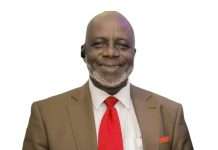(By Prof. Kenneth A. Attafuah)
The Pharmanews Leadership Series is a newly introduced section of Pharmanews, and is dedicated to the promotion of health care leadership and management. The essence is to inspire visionary leadership by providing exemplary information to health care professionals.
In this maiden edition, we provide excerpts from the lecture, “Effective Leadership for Optimum Performance” as presented by Prof Kenneth Attafuah, at a Pharmanews workshop in Accra, Ghana.
Leadership means leading people, e.g., employees and stakeholders, to accomplish specific goals. Leadership is about making things happen; getting significant new things done and making improvements.
Prof. Stephen Adei once said, “Leadership is cause, everything else is effect.”Leadership is the central causative factor for progress or stagnation or retrogression among groups. Sound leadership is central to advancement in any field of human endeavour and its absence is often both an index and a predictor of decay.
History is replete with examples of communities and organisations that were transformed from nothingness, inefficiency and shambles into shining metropolises of wealth, efficiency and opulence. Poverty (of ideas and substance), ineffectiveness and inefficiency are not virtues, and enduring them for long is a mark of sustained failure, not humility. This poverty, ineffectiveness and inefficiency are horrors from which we can and must flee through hard work, sound leadership and strategic management.
Why focus on leadership?
There are different reasons for which we must focus on this important subject of leadership, some of which include:
A. To meet the challenges of propelling performance and productivity. Ensuring and maintaining profitability. Managing change in a rapidly growing workplace under politically volatile times (Reorganising, downsizing, rightsizing, “left-out-sizing”, etc.
B. To avoidabusive exercise of power.
C. To meet the demands for growth and prosperity.
D. To Respond to change and ever-emerging challenges occasioned by competition over limited resources, impact of technological advances in all spheres of human endeavour, globalisation, and conflicts
Elements of leadership
Different lists of leadership models and competences abound for achieving excellence.The leadership model adopted by a given organisation would depend on:
• Nature of the organisation.
•Mission (reason for being in business).
• Vision (where it wants to be and what it intends to be).
• Values (the guiding principles of how itfulfilsits mission and achieves its vision).
Every organisation has a unique combination of missions and values. Each organisation has its own definition of leadership and must develop the unique list of competencies required of its leaders. Hence, there are as many different types of leadership models and leaders as there are organisations.
Leadership types (Adapted from “The Wall Street Journal Guide to Management” by Alan Murray)
1.Visionary
The hallmark of this style is vibrant enthusiasm and a clear vision that motivates people by making clear how their work fits into the larger vision of the organisation.
2.Coaching
The coaching leader helps employees identify their unique strengths and weaknesses and tie them to personal and career aspirations. A coaching approach guarantees that people know what is expected of them and how they can fulfil the expectations.
3.Democratic
This style works best when leaders need guidance, input and buy-in from employees and stakeholders. It can drive up flexibility and responsibility in the process of building trust, respect and commitment.
4. Affiliative
This style is particularly useful when leaders need to increase team harmony, improve morale and communication, and repair broken trust.
5. Commanding
“This is classic model, “military” style leadership – probably the most often used, but the least often effective”.
According to Daniel Goleman, author of “Emotional Intelligence”, the commanding leadership style rarely involves praise, frequently employs criticism, undercuts morale and job satisfaction, only works effectively in a crisis when an urgent turnaround is needed.
6. Pacesetting
In pacesetting, the leader sets high standards for performance. He is obsessed about doing things better and faster. He asks the same of everyone.
Pacesetting should be used sparingly, because it can weaken morale, make people feel as if they are failing. Italso has the potential to poison the climate.
The commanding and pacesetting styles are congruent with the heroic model. When people are experiencing fear, threat, worry, or embarrassment, they move into the withdrawal (fight or flight) side of their brain and disengage, waiting to react rather than moving into the approach side of their brains for greater engagement.
Attributes of an effective leader
• Articulate, committed, informed and dynamic.
• Goal-oriented. As a leader, are you goal-oriented?
• Achievement. What are the time-tested accomplishments of the leader?
• Acceptance by the group.
• Competence. Intellectual and emotional.
• Capacity to deliver promises.
• Concern for subordinates.
• Responsibility. How responsible is the person in his or her business and family dealings?
• Participation. Willingness to participate in group activities.
• Communication. Ability to communicate information and decisions.Effective communication allows for involvement of other parties in decision making.It also eliminates doubts and concerns.
• Dependability. An effective leader can be counted upon to deliver.
• Flexibility.
• Initiative. Great leaders take the lead, they provide direction.
• Loyaltyto the organisation, cause and team members.
• Enablement. Ability to provide means or opportunities for the team mates.
• Objectivity. Is the leader able to perceive, appreciate or present issues without being influenced by sentiments and prejudices?
• Perceptive. Is the leader able to observe and appreciate the realities of his/her environment?
• Self-Development. Is the leader on the continuous path of personal development?
• Trustworthiness.
• Relaxed. He is not domineering or exploitative.
Key responsibilities of an effective leader
• Providing vision and direction for the group.
• Making decisions.
• Articulating policies, goals and objectives of the group.
• Motivating and inspiring subordinates.
• Determining realistic performance objectives – e.g., quality, quantity and safety.
• Communicating to subordinates what specifically is expected of them.
• Providing subordinates with the necessary resources to perform their tasks
• Delegating authority when necessary.
• Encouraging participation as much as possible.
• Removing barriers and stumbling blocks to enable effective performance.
• Appraising performance and communicating results.
Achievingeffective leadership
To achieve effective leadership, the leader must continually improve his or her leadership styles. He must understand, though, that the “organisation” is an important element of the power of leadership. What this means is that there is need to appreciate the difference between organisational power and personal power. Organisational/office power must not be seen as an extension of his personal power.
Remember the following points of wisdom:
· Personal power is perpetual and ambulatory (it moves with the leader, from one position/organisation to the other.) Personal power refers to the influence over others, the source of which resides in the person, instead of being vested by the position he or she holds.
· Institutional (organisational/office) power is transient in the leader and resides in the organisation (it doesn’t move with the leader).
Personal power is crucial for effective leadership at all levels – personal, family, organisational and governmental. Personal leadership development is therefore crucial for enhancing personal influence and renewing people’s trust. It is also useful for improving the leader’s relationships with others (family members, co-workers, healthcare providers, suppliers and administrators); patients’ relationship and care; business prospects; and general happiness.
Emotional competencies and the resilient leader
Emotional competence is built on the cornerstones of self-awareness and accurate self-assessment.Emotional intelligence consists of self-awareness, self-management, social awareness and interpersonal effectiveness. Essentially, it allows us to be cognizant of the impact we’re having on our environment, and flexing our styles to promote resilience, resonance and wellbeing in those we influence.
Developing competence in social awareness and relationship management skills is crucial for strengthening interpersonal and social connectedness. Interpersonal and social connectednessarenecessary for any organisation to learn and to thrive as a living system
The key ingredients of interpersonal and social connectedness are:
• Empathy
• Organisational awareness
• Service orientation
• Influence
• Inspirational leadership
• Conflict management
• Teamwork and collaboration
• Developing others
• Being an effective change catalyst.
Supremacy of variety
Many studies have shown that the more styles a leader exhibits, the better. Those who have mastered four or more leadership styles have the best work climate and business results.
Resilient leaders are fluid. Having access to the full range of styles is what promotes resilient leadership and consequently, resilient organisations. Since all the leadership styles can have either a resonant or dissonant effect depending on the situation, every leader must be attuned to the impact she/he is having on others; and willing to adjust her/his style to get the best results.
With an expanded repertoire of leadership styles, health care providers can become even more effective leaders and maximise the influence they have and the contributions they can make as professionals within the hub of the health care system.
Wherea leader possesses and judiciously applies varied styles of leadership, there is always increased personal sense of well-being and resilience. Patients under his care will also experience and enjoy this sense of wellbeing and satisfaction.
Professor Kenneth A. Attafuahis the director, William Ofori-Atta Institute for Leadership & Governance, Central University College, Accra, Ghana.










